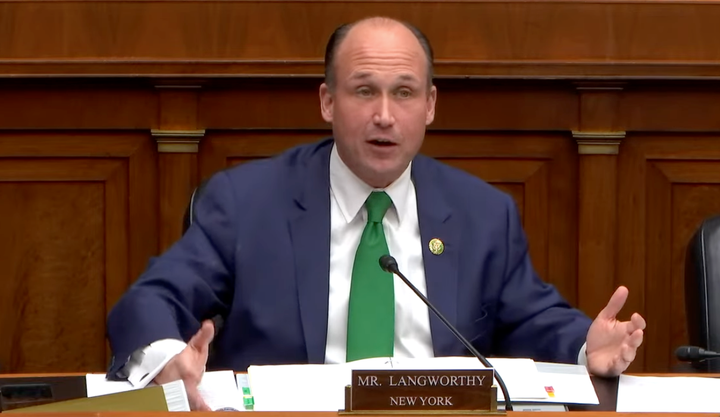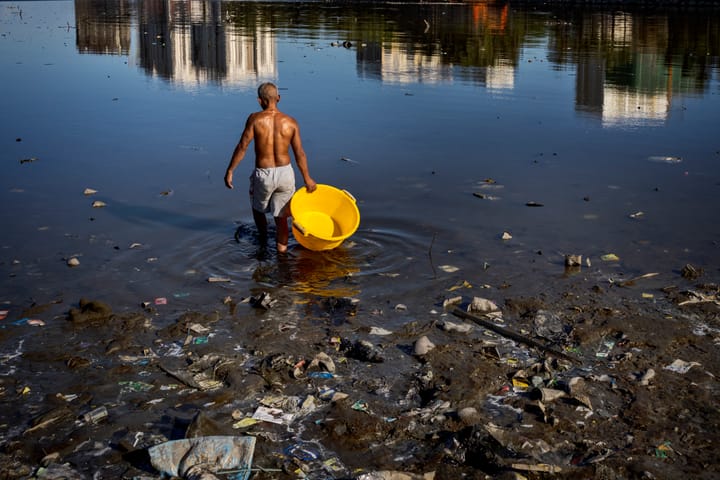Copyright, Truthout.org. Reprinted with permission. Click here to support Truthout.
House Democrats have finally unveiled a flurry of climate bills aimed at reducing greenhouse gas emissions, but activists say only one proposal represents the “gold standard” for tackling the climate crisis: Legislation introduced by Sen. Bernie Sanders and Rep. Alexandria Ocasio-Cortez that would ban fracking nationwide. While none of these bills are likely to become law under President Trump, together they form the contours of a fierce debate among Democrats and environmentalists over the future of energy in the age of climate disruption.
Ocasio-Cortez, the House sponsor of the Green New Deal legislation and a Sanders campaign surrogate, introduced the House version of fracking ban on Wednesday. Since its introduction in the Senate on January 31, the fracking ban has divided presidential hopefuls and drawn criticism from conservatives and the industry. The legislation would ban fracking 2,500 feet from home and schools in 2021 to protect public health and institute a nationwide ban on the controversial oil and gas extraction process by 2025. Both versions would require the Labor Department to develop a “just transition” plan for placing fossil fuel workers into new jobs within their own communities.
Fracking has enabled an oil and gas boom that prompted public backlash and made the U.S. a fossil fuel powerhouse capable of dominating global production for decades. Centrist Democrats have long seen fracked gas as a cheap, cleaner burning “bridge fuel” to replace coal. However, environmentalists argue that methane leaking from fracking infrastructure contributes to global carbon emissions, and allowing the boom to continue will lock in climate-warming fossil fuel pollution for decades.
“The science is clear: Fracking is a leading contributor to our climate emergency. It is destroying our land. It is destroying our water and it is wreaking havoc on our communities’ health,” Ocasio-Cortez said in a statement on Wednesday. “We must do our job to protect our future from the harms caused by the fracking industry and its methane emissions.”
While challenging the fossil fuel industry is central to Sanders’s presidential campaign, other lawmakers are taking a more moderate approach. On Tuesday, Sen. Tom Carper and other Democrats introduced the Clean Economy Act of 2020, which requires federal regulators to set goals for eventually reaching “net zero” greenhouse gas emissions in the U.S. by 2050. Net zero by 2050 is the international goal set by the Paris climate agreement and what scientists say is needed to avert the worst impacts of climate change.
Net zero emissions means that the climate-warming gases produced by humans by, say, driving a car or running an electric power plant, are canceled out by reductions in emissions. The Clean Economy legislation is vague. It would “empower” federal agencies to “implement policies that increase the ability” of the nation to reduce emissions while “staying globally competitive,” according to a press release. This likely means public investments in renewables as well as infrastructure and technology that private “innovators” hope will save us from climate chaos, such as carbon capture schemes and geoengineering plants that remove greenhouse gases from the air. A new American Psychological Association survey found that more than half of U.S. adults say climate is the most important issue today.
Last month, Democrats in the House Energy and Commerce Committee introduced a bill with a similar goal: achieving a 100 percent “clean energy economy” — with net-zero emissions — by 2050. The legislation creates a number of federal initiatives to help states and the energy sector (and electric utilities in particular) reduce emissions, while increasing efficiency in the transportation, housing and construction sectors. Like the Senate bill, the House proposal contains language addressing the disproportionate impact that pollution has on low-income communities and communities of color.
The response to both “clean energy” bills from environmentalists has been mixed. Some groups appear ready for lawmakers to take any action on climate, even if the steps are small. Others say the legislation simply does not go far enough to end reliance on fossil fuels. Indeed, under both bills, the oil and gas industry would likely continue conducting business as usual for decades; the legislation relies on the hope that heavy public investment in renewables and technological fixes will mitigate the industry’s impacts.
“The Carper bill is marginally better than the [House] bill, but neither one of them does what actually needs to be done to stop the worsening effects of climate change,” said Mitch Jones, policy director at Food and Water Watch, in an interview. “Both allow the possibility of carbon capture, which only makes sense in the context of continuing to use fossil fuels. And both of them also leave open the possibility of using ‘cap-and trade’ and other market schemes to trade pollution credits instead of actually reducing pollution.”
Jones said what’s needed are “prohibitions” on new fossil fuel developments that ensure production will continue for decades to come. That’s why climate justice activists are fired up about Sanders and Ocasio-Cortez’s proposals to ban fracking. While that bill would not end oil and gas production altogether — other drilling methods would still be legal — it would pull the brakes on an industry that is rapidly expanding infrastructure and currently producing so much fossil fuel that prices have dropped and its own profits have suffered.
“In terms of specifically fighting against the supply side of fossil fuels and fighting against the continuation of extracting and burning fossil fuels, the Sanders and Ocasio-Cortez bills are the gold standards in this Congress,” Jones said.
Meanwhile, there are other, less sweeping climate initiatives in Congress, as well as new legislation to address the petrochemical industry’s aggressive push to expand plastics production at a time when plastic waste is choking the world’s oceans. The problem is directly connected to the gas glut created by the fracking boom, which in turn has created incentives to soak up excess reserves with new petrochemical plants that make plastic products from oil and gas.
With Sanders emerging as a clear frontrunner in the presidential race, we may soon see if voters believe that drastic times demand a definitive end to the fracking boom.
These bills reveal a divide among Democrats over what should be done if voters hand the party power in November. Climate is shaping up to be the defining issue of the 2020 campaign; a new American Psychological Association survey found that more than half of U.S. adults say climate is the most important issue today.
Sanders’s bill to ban fracking has burst the fissure wide open. In bids to win over the party’s progressive wing, Sen. Elizabeth Warren and some other presidential hopefuls have said they also support a nationwide ban, although they have not released specific plans to do it. Pete Buttigieg, the other current frontrunner, has said he supports banning new fracking projects and phasing out the practice as the country transitions to renewables. Joe Biden, Amy Klobuchar and other candidates in the “bridge fuel” camp oppose a ban but would impose tougher regulations. With Sanders emerging as a clear frontrunner in the presidential race, we may soon see if voters believe that drastic times demand a definitive end to the fracking boom.
Air
Meanwhile, researchers are continually discovering new ways that climate disruption is rapidly changing the Earth and its weather patterns. Scientists are currently observing atmospheric “rivers in the sky” that are growing more intense with climate change, increasing the risk of flooding across the U.S and particularly in western states, according to Bloomberg News.
Meteorological airplanes are measuring narrow bands of moisture that originate in the Pacific Ocean and travel eastward 1,000 to 2,000 feet above the continental U.S. As oceans warm, more moisture gathers in these atmospheric rivers, bringing higher levels of rain and snowfall onshore. The problem is particularly acute in the western U.S., where atmospheric rivers have caused 84 percent of the flood damage in 11 western states since the late 1970s, according to a recent study by the Army Corps of Engineers. That damage costs about $1.1 billion annually.
A dozen trips to gather meteorological data are planned this year with help from the National Oceanic and Atmospheric Administration, double the number of flights flown last year. Scientists hope to develop better warning systems so local officials and civil engineers on the ground can prepare for and prevent catastrophic flooding. Atmospheric rivers originate in oceans worldwide, so the data will be helpful for understanding rainfall in other countries as well. The data will also help officials in states like California manage shrinking water supplies fed by rainfall.
Earth
Climate change threatens over 1 million plant and animal species with extinction. This week reports circulated the media warning that chinstrap penguins living along the Antarctic peninsula are disappearing in record numbers, and scientists suspect climate change to be the culprit.
A number of species that are crucial to human survival are also under threat. Across the planet, global warming could contribute to the continued decline of bumble bees, one of the main pollinators of crops we grow for food, according to new research published in Science.Warming temperatures and record-breaking heat waves are damaging bee populations that we depend on to grow food and maintain healthy ecosystems.
Scientists studied a large, long-term dataset on 66 species of bumble bees across North American and Europe and determined that the “increasing frequency of unusually hot days” is reducing the size of bee colonies, decreasing species diversity, and wiping out whole populations in some local areas. These effects were observed independently from other factors, such as humans changing the way agricultural lands are used.
There are several factors suspected to be contributing to pollinator declines, including disease and pesticides. This study warns that warming temperatures and record-breaking heat waves are also damaging bee populations that we depend on to grow food and maintain healthy ecosystems.
Water
More evidence is emerging that the shifting climate will change the way populations of fish and mollusks are farmed and caught from the ocean for food.
Certain species of fish, such as the Atlantic salmon and European sea bass, could be particularly vulnerable to population decline, and environmental changes in the Arctic, tropical and subtropical oceans will force fishers and seafood farmers to adapt to new conditions, according to a new study published in Global Change Biology. Previous research has already shown that rising sea temperatures threaten Atlantic salmon.
The study was conducted with “sustainable development” and a growing demand for seafood in mind. Researchers studied data on water temperature, oxygen levels and other factors that impact seafood populations. Some regions of the world could fare better than others. As waters warm, certain fish populations will seek cooler waters in northern latitudes.
Canada’s Pacific coast could lose 60 to 84 percent of area suitable for salmon, while Norway and Sweden may see their Atlantic salmon areas double in size, depending on various climate models. While Canadians would have less salmon to eat, farmers would have more area to seed and harvest oysters.
Tropical and subtropical regions of the world that tend to be lower-income and rely most on seafood for food security are likely to suffer the greatest losses to aquaculture and fishing systems, researchers said. These regions could lose 10 to 40 percent of ocean areas suitable for seafood farming, depending on what level of action humans take to mitigate climate change.
Fire
Nature has finally brought relief to Australia, where massive bushfires erupted in recent months after the country suffered its hottest and driest year on record. Torrential rain came down across the continent’s eastern coast over the weekend, putting out two of the most severe “megafires” burning there, according to reports. Rain is falling in historic amounts, and officials remain hopeful that remaining bushfires will be finally extinguished.
The damage in Australia is unprecedented. At least 34 people have died, 3,000 homes are destroyed and nearly 30 million acres of land have gone up in flames. More than 1 billion animals are estimated to have died.
The political fallout from the megafires continues in Australia and across the world. Expatriates have taken to the media worldwide, and particularly in the U.S. and Britain, demanding that authorities recognize the root cause of the disaster and take action on climate change. Yet the climate denialism continues. Last month, reports surfaced indicating a coordinated effort by the right-wing media to spread misinformation about Australia’s megafires to shift the blame away from climate change and protect conservative Australian politicians.
The U.S. and Australia have a lot in common. Both countries have experienced catastrophic wildfires and other climate-related disasters. Both countries have long depended on coal and other fossil fuels for energy, leaving the industry with enormous political power and every incentive to maintain the status quo. In Australia, the fossil fuel industry is doubling down on political donations to friendly politicians as public concerns over climate grow. In the U.S., President Trump has billed himself as the industry’s best friend.
Yet the conversation is quickly changing, just like the world around us. Not long ago, the very idea of banning fracking in the U.S. seemed like an environmentalist pipe dream. Now, multiple Democratic presidential candidates are behind such a ban. Sanders introduced his bill to ban fracking last month and went on to finish at the top of the Iowa caucuses and win the New Hampshire primary. These days, it’s becoming painfully clear that political questions about climate policy are also questions of survival. With young people everywhere fearing for their future, Democratic primary voters are taking note.
Related:



